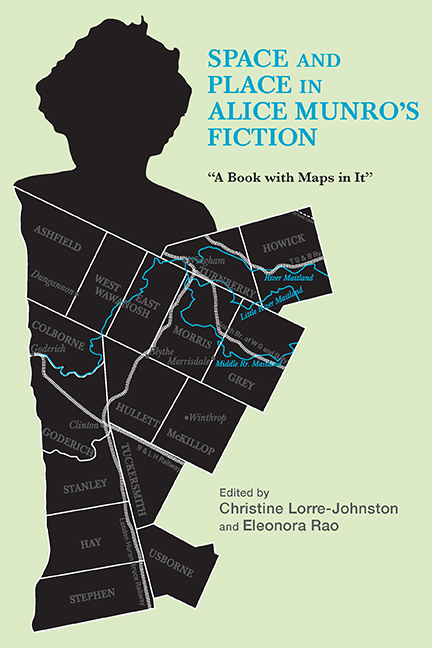Book contents
- Frontmatter
- Contents
- List of Illustrations
- Acknowledgments
- List of Abbreviations
- Introduction
- Part I Conceptualizing Space and Place: Houses, Landscapes, Territory
- 1 Where Do You Think You Are? Alice Munro's Open Houses
- 2 “Whose House Is That?” Spaces of Metamorphosis in Alice Munro's Dance of the Happy Shades, Who Do You Think You Are?, and The View from Castle Rock
- 3 Mapping the Vernacular Landscape in Alice Munro's “What Do You Want to Know For?” and Other Stories
- 4 Stories in the Landscape Mode: A Reading of Alice Munro's “Lives of Girls and Women,” “Walker Brothers Cowboy,” and “Lichen”
- 5 “What Place Is This?” Alice Munro's Fictional Places and Her Place in Fiction
- 6 “The Emptiness in Place of Her”: Space, Absence, and Memory in Alice Munro's Dear Life
- 7 Down the Rabbit Hole: Revisiting the Topos of the Cave in Alice Munro's Short Stories
- Part II Close Readings of Space and Place
- Bibliography
- Notes on the Contributors
- Index
2 - “Whose House Is That?” Spaces of Metamorphosis in Alice Munro's Dance of the Happy Shades, Who Do You Think You Are?, and The View from Castle Rock
from Part I - Conceptualizing Space and Place: Houses, Landscapes, Territory
Published online by Cambridge University Press: 15 August 2018
- Frontmatter
- Contents
- List of Illustrations
- Acknowledgments
- List of Abbreviations
- Introduction
- Part I Conceptualizing Space and Place: Houses, Landscapes, Territory
- 1 Where Do You Think You Are? Alice Munro's Open Houses
- 2 “Whose House Is That?” Spaces of Metamorphosis in Alice Munro's Dance of the Happy Shades, Who Do You Think You Are?, and The View from Castle Rock
- 3 Mapping the Vernacular Landscape in Alice Munro's “What Do You Want to Know For?” and Other Stories
- 4 Stories in the Landscape Mode: A Reading of Alice Munro's “Lives of Girls and Women,” “Walker Brothers Cowboy,” and “Lichen”
- 5 “What Place Is This?” Alice Munro's Fictional Places and Her Place in Fiction
- 6 “The Emptiness in Place of Her”: Space, Absence, and Memory in Alice Munro's Dear Life
- 7 Down the Rabbit Hole: Revisiting the Topos of the Cave in Alice Munro's Short Stories
- Part II Close Readings of Space and Place
- Bibliography
- Notes on the Contributors
- Index
Summary
I was moving forward into space, but I would never come home again.
—Bryn Greenwood, All the Ugly and Wonderful ThingsHome isn't a place, it's a feeling.
—Cecelia Ahern, Love, RosieONE OF THE PRIVILEGES of being an outsider is that one is not expected to play by the insider's rules. Outsiders, whether conscious and volitional or existential, have transgressed boundaries. Metaphorically or pragmatically, they have moved across space to cross over a boundary and stand on the edge of it—with or without success. Then, their existence itself becomes a breaking of boundaries. Outsiderdom, to a greater or lesser extent, permeates Alice Munro's texts, from the very beginning of her literary career. In Lives of Girls and Women Del Jordan, true to her surname, is the first to traverse figuratively a bridge and explore the other bank. She actually defines herself as an “outsider” (LiGW, 69). Rose, the protagonist of Who Do You Think You Are? despite her efforts to fit in, will remain on the threshold wherever she goes. She will have the freedom of the stranger, the freedom to leave; her permanence, however protracted, will tend to be temporary. The stranger / outsider stands between friend and enemy, order and chaos, the inside and the outside. The stranger, to quote Zygmunt Bauman, stands for “the treacherousness of friends, for the cunning disguise of the enemies, for fallibility of order, vulnerability of the inside.”
In Alice Munro's fiction, the representations of the protagonist as outsider carry undercurrent processes of assimilation, or of attempts at being assimilated, again with or without success. Psychoanalysis and sociology alike have drawn attention to such dynamics, and to the circumstances that the outsider or the stranger lacks. It could be lack of cultural affiliation, of community, of belonging, of affect, of home. A preoccupation with feeling at home or not feeling at home recurs almost obsessively in these texts.
- Type
- Chapter
- Information
- Space and Place in Alice Munro's Fiction“A Book with Maps in It”, pp. 41 - 62Publisher: Boydell & BrewerPrint publication year: 2018



